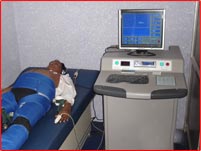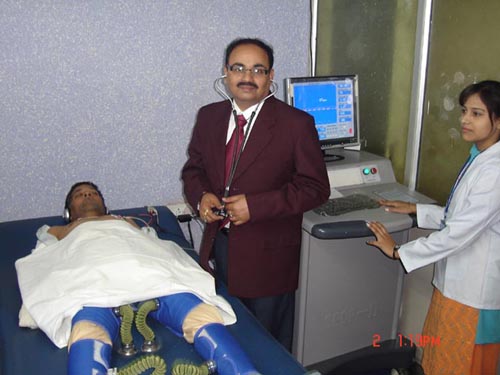|
|
|
It's also for those who have other health problems such
as diabetes or, as in Belanger's case, another surgery
and cancerPatients usually receive EECP treatment for one hour a
day, five days a week for seven weeks. They lie on a padded
table and are strapped with three sets of compressive cuffs
around their calves and lower and upper thighs.
Electronically controlled valves connected to the cuffs
carry low air pressure to the arteries and veins, monitored
by an electrocardiogram. |
 |
A
therapy for angina called EECP may make it possible for
you to take part in the activities you enjoy once again
without suffering from attacks of angina. This
treatment, which does not involve surgery or
hospitalization, has helped many people with coronary
artery disease.
This treatment is called Enhanced External Counter
pulsation, and will be referred to as EECP during the
presentation. EECP can eliminate or reduce angina

EECP has two potentially
beneficial actions on the heart. First, the milking
action of the leg cuffs increases the blood flow to the
coronary arteries. (The coronary arteries, unlike other
arteries in the body, receive their blood flow after
each heartbeat instead of during each heartbeat. EECP,
effectively, “pumps” blood into the coronary arteries.)
Second, by its deflating action just as the heart begins
to beat, EECP creates something like a sudden vacuum in
the arteries, which reduces the work of the heart muscle
in pumping blood into the arteries.
Both of these
actions have long been known to reduce cardiac ischemia
(the lack of oxygen to the heart muscle) in patients
with coronary artery disease. Indeed, an invasive
procedure that does the same thing, intra-aortic counter
pulsation (IACP, in which a balloon-tipped catheter is
positioned in the aorta, which then inflates and
deflates in time with the heartbeat), has been in
widespread use in intensive care units for decades, and
its effectiveness in stabilizing extremely unstable
patients is well known.

EECP now appears to be
quite effective in treating chronic stable angina. A
randomized trial with EECP, published in the Journal
of the American College of Cardiologyin 1999, showed
that EECP significantly improved both the symptoms of
angina (a subjective measurement) and exercise tolerance
(a more objective measurement) in patients with coronary
artery disease. EECP also significantly improved
“quality of life” measures, as compared to placebo
therapy.
|